
A | B | C | D | E | F | G | H | CH | I | J | K | L | M | N | O | P | Q | R | S | T | U | V | W | X | Y | Z | 0 | 1 | 2 | 3 | 4 | 5 | 6 | 7 | 8 | 9
| Russian Navy | |
|---|---|
| |
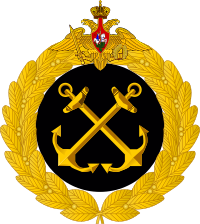 Emblem of the Russian Navy | |
| Active |
|
| Country | Russia |
| Branch | Navy |
| Size | 160,000 active duty (2023)[2] Approx. 370 active ships[3] |
| Part of | Armed Forces of the Russian Federation |
| Headquarters | Admiralty building, Saint Petersburg |
| Motto(s) | "С нами Бог и Андреевский флаг!" (God and St. Andrew's flag are with us!) |
| March |
|
| Anniversaries | Navy Day (last Sunday in July) Submariner's Day (19 March) Surface Sailor's Day (20 October) |
| Fleet | 1 aircraft carrier 2 battlecruisers 2 cruisers 10 destroyers 11 frigates 80 corvettes 11 landing ship tanks 60 landing craft 18 special-purpose ships 4 patrol ships 56 patrol boats 45 mine countermeasures vessels 8 special-purpose submarines 65 active ballistic missile/cruise missile and attack submarines[4] |
| Engagements | |
| Website | structure |
| Commanders | |
| Commander-in-Chief | Admiral Aleksandr Moiseyev (acting)[5] |
| First Deputy Commander-in-Chief | Admiral Aleksandr Nosatov |
| Deputy Commander-in-Chief | Vice-Admiral Vladimir Kasatonov |
| Insignia | |
| Ensign |  |
| Jack |  |
| Pennant | |
| Patch | 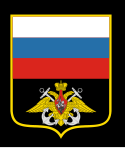 |
| Middle Emblem |  |
| Insignia |  |
The Russian Navy[a] is part of the Russian Armed Forces. It has existed in various forms since 1696. Its present iteration was formed in January 1992 when it succeeded the Navy of the Commonwealth of Independent States (which had itself succeeded the Soviet Navy following the dissolution of the Soviet Union in late December 1991).
The Imperial Russian Navy was established by Peter the Great (Peter I) in October 1696. The symbols of the Russian Navy, the St. Andrew's ensign (seen to the right), and most of its traditions were established personally by Peter I.
The Russian navy possesses the vast majority of the former Soviet naval forces, and currently comprises the Northern Fleet, the Pacific Fleet, the Black Sea Fleet, the Baltic Fleet, the Caspian Flotilla, the permanent task force in the Mediterranean, Naval Aviation, and the Coastal Troops (consisting of the Naval Infantry and the Coastal Missile and Artillery Troops).
The Russian navy suffered severely with the collapse of the Soviet Union due to insufficient maintenance, lack of funding, and subsequent effects on the training of personnel and timely replacement of equipment. Another setback was attributed to Russia's domestic shipbuilding industry, which was in decline due to the absence of modern hardware and technology.
In 2013, a rise in gas and oil prices enabled a sort of renaissance of the Russian Navy due to increased available funds, which may have allowed Russia to begin "developing the capacity to modernize".[6] In August 2014, Defence Minister Sergei Shoigu said that Russian naval capabilities would be bolstered with new weapons and equipment within the next six years in response to the enlargement of NATO and the beginning of the Russo-Ukrainian War.[7][needs update]
History
| Russian Armed Forces |
|---|
 |
| Staff |
| Services (vid) |
| Independent troops (rod) |
| Special operations force (sof) |
| Other troops |
| Military districts |
| History of the Russian military |
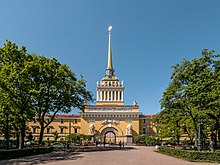
The 1991 dissolution of the Soviet Union led to a severe decline in the Russian Navy. Defence expenditures were severely reduced. Many ships were scrapped or laid up as accommodation ships at naval bases, and the building program was essentially stopped. Sergey Gorshkov's buildup during the Soviet period had emphasised ships over support facilities, but Gorshkov had also retained ships in service beyond their effective lifetimes, so a reduction had been inevitable in any event.[8] The situation was exacerbated by the impractical range of vessel types which the Soviet military-industrial complex, with the support of the leadership, had forced on the navy—taking modifications into account, the Soviet Navy in the mid-1980s had nearly 250 different classes of ship.[9]
The Kiev-class aircraft carrying cruisers and many other ships were prematurely retired, and the incomplete second Admiral Kuznetsov-class aircraft carrier Varyag was eventually sold to the People's Republic of China by Ukraine. Funds were only allocated for the completion of ships ordered prior to the collapse of the USSR, as well as for refits and repairs on fleet ships taken out of service since. However, the construction times for these ships tended to stretch out extensively: in 2003 it was reported that the Akula-class submarine Nerpa had been under construction for fifteen years.[10]
Storage of decommissioned nuclear submarines in ports near Murmansk became a significant issue, with the Bellona Foundation reporting details of lowered readiness. Naval support bases outside Russia, such as Cam Ranh Bay in Vietnam, were gradually closed, with the exception of the modest technical support base in Tartus, Syria to support ships deployed to the Mediterranean. Naval Aviation declined as well from its height as Soviet Naval Aviation, dropping from an estimated 60,000 personnel with some 1,100 combat aircraft in 1992 to 35,000 personnel with around 270 combat aircraft in 2006.[11] In 2002, out of 584 naval aviation crews only 156 were combat ready, and 77 ready for night flying. Average annual flying time was 21.7 hours, compared to 24 hours in 1999.[12]
Training and readiness also suffered severely. In 1995, only two missile submarines at a time were being maintained on station, from the Northern and Pacific Fleets.[13] The decline culminated in the loss of the Oscar II-class submarine Kursk during the Northern Fleet summer exercise that was intended to back up the publication of a new naval doctrine.[14] The exercise was to have culminated with the deployment of the Admiral Kuznetsov task group to the Mediterranean.[citation needed]
As of February 2008, the Russian Navy had 44 nuclear submarines with 24 operational; 19 diesel-electric submarines, 16 operational; and 56 first and second rank surface combatants, 37 operational.[15] Despite this improvement, the November 2008 accident on board the Akula-class submarine attack boat Nerpa during sea trials before lease to India represented a concern for the future.[16]
The strength and quality of the Russian Navy started to improve during the 2010s. In 2012, as part of an ambitious rebuilding effort, President Vladimir Putin announced a plan to build 51 modern ships and 24 submarines by 2020.[17] Of the 24 submarines, 16 were to be nuclear-powered.[18] On 10 January 2013, the Russian Navy finally accepted its first new Borei-class SSBN (Yury Dolgorukiy) for service.[19] A second Borei (Aleksandr Nevskiy) was undergoing sea trials and entered service on 21 December 2013.[20]
A third Borei-class boat (Vladimir Monomakh) was launched and began trials in early 2013, and was commissioned in late 2014.[21] As of early 2022, five Borei-class boats are in service, along with three Yasen-class nuclear attack submarines. More vessels of these classes are building along with additional Lada and Improved-Kilo-class conventional attack submarines. The surface fleet is also being modernized, principally by introducing at least six new classes of corvette/offshore patrol vessels, a new class of frigate (the Admiral Gorshkov class), as well as new classes of amphibious ships and support vessels. In 2019, total tonnage of the Russian Navy stood at 1,216,547 tonnes.[22]
Invasion of Ukraine and losses
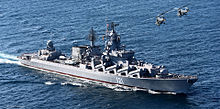
In 2022, the Russian Navy took part in the Russian invasion of Ukraine, starting with the attack on Snake Island at the beginning of the war, at which the Ukrainian defenders told the Russian cruiser Moskva, flagship of the Black Sea; "Russian warship, go fuck yourself", before subsequently being captured by Russian forces. Moskva sunk on 14 April 2022 after a fire broke out and forced the crew to evacuate. The Ukrainian military reported that they hit the ship with Neptune anti-ship missiles, however the Russian military did not confirm this. The ship subsequently capsized and sank while the Russian Navy was attempting to tow her into port. The sinking of Moskva is the most significant Russian naval loss in action since World War II.[23] In December 2023, the Russian landing ship Novocherkassk was also destroyed after being hit by Ukrainian cruise missiles.[24]
On 31 January 2024, Ukrainian sea drones struck the Russian Tarantul-class corvette Ivanovets in the Black Sea, causing the ship to sink.[25][26] Two weeks later on 14 February, the same type of Ukrainian sea drones struck and sank the Russian Landing ship Tsezar Kunikov.[27][28] On 5 March, the patrol boat Sergei Kotov was also lost to sea drones.[29]
Structure

| Navies of Russia |
|---|
Since 2012 the headquarters of the Russian Navy (Russian Navy Main Staff) is once again located in The Admiralty in Saint Petersburg. Russian naval manpower is a mixture of conscripts serving one-year terms and volunteers (Officers and Ratings). In 2006 the IISS assessed there were 142,000 personnel in the Russian Navy. This personnel number includes the Naval Infantry (Marines) and the Coastal Missile and Artillery Troops. As of 2008 the conscription term was reduced to one year and a major downsizing and reorganization were underway. In 2008, plans were announced to move the headquarters to the Admiralty building in St. Petersburg, the historic location of the headquarters of the Imperial Russian Navy. The Navy Staff finally relocated there in November 2012.[citation needed]
The Russian Navy is organised into four combat services - the Surface Forces, the Submarine Forces, the Naval Aviation and the Coastal Troops.[30] Additionally the navy also includes support units afloat and ashore. It does not include special forces. The Naval Spetsnaz brigades are part of the Main Intelligence Directorate attached to the respective fleets and the Counter-Diversionary Forces and Assets (ПДСС) (which are units, protecting the Navy from incursions of enemy special forces) fall within the Coastal Forces.
During the Cold War the Soviet Armed Forces made the distinction between the various naval commands. The main fleets were the Northern and the Pacific Fleet. They were tasked with independent operations on the high seas and for that reason included strategic surface, submarine and air forces, including the country's naval nuclear deterrent. Due to the limited geography of the Baltic and the Black Seas the respective Baltic and Black Sea Fleets were given a more circumscribed role in support of adjacent ground formation (the Main Command of the Troops of the Western Direction in Legnica (Poland) and the Main Command of the Troops of the South-Western Direction in Chișinău).
These two fleets were armed with shorter-range weapon systems than the main fleets (diesel-electric submarines, Sukhoi Su-24 fighter-bombers and a larger quantity of frigates and corvettes). Due to the closed nature of the Caspian Sea (still connected to the Baltic and Black Seas through the Volga River and the system of rivers and canals and navigable for ships of corvette size) its Caspian Flotilla had an even more limited role than the Fleets and played a defensive role supporting the Main Command of the Troops of the Southern Direction in Baku.
With the end of the Cold War a significant reduction in forces followed. Before the 2008 Russian military reform, the four fleets were ranked as equal in status to the six Military Districts. With the reform measures going into force the number of Military Districts was reduced and became new Joint Strategic Commands and the four fleets and one flotilla were subordinated to them with status equal to the Ground Forces and the Air Forces armies. Due to Russia's increased interests in the Arctic region and the importance of Russia's western/northwestern maritime defence the Northern Fleet, originally part of the Joint Strategic Command West (Western Military District), on 12 December 2014 became the basis for the newly formed fifth Northern Fleet Joint Strategic Command.
Submarine and surface forces
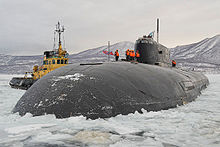
The submarine and surface forces form the backbone of the Navy. The submarines form part of dedicated submarine squadrons and flotillas or part of squadrons and flotillas of mixed composition together with major surface combatants. The Russian Navy retains a rigid structure, whose levels of command could, according to military regulations, be directly equalled to the corresponding ground and air forces counterparts:
| Part of | Fleet unit | Officer commanding | Ground and air forces equivalent | Officer commanding | Notes |
|---|---|---|---|---|---|
| General Staff of the Armed Forces of the Russian Federation | Commander-in-Chief of the Navy
(Главнокомандующий Военно-морским флотом Российской Федерации) |
Admiral | Commander-in-Chief of the Land Forces
(Главнокомандующий Сухопутными войсками Российской Федерации) Commander-in-Chief of the Aerospace Forces (Главнокомандующий Воздушно-космическими силами Российской Федерации) |
Colonel general | |
| Chief of Staff and First Deputy Commander of the Navy
(Начальник штаба — первый заместитель Главнокомандующего ВМФ) |
Vice admiral | Chief of the Main Staff and First Deputy Commander of the Land Forces
(Начальник Главного штаба Сухопутных войск — первый заместитель главнокомандующего Сухопутными войсками) Chief of the Main Staff and First Deputy Commander of the Aerospace Forces (Начальник Главного штаба — первый заместитель Главнокомандующего Воздушно-космическими силами) |
Lieutenant general | ||
| Deputy Commander of the Navy
(Заместитель Главнокомандующего ВМФ) |
Vice admiral /
Lieutenant general (Marines and Naval Aviation) |
Deputy Commander of the Land Forces
(Заместитель Главнокомандующего СВ) Deputy Commander of the Aerospace Forces (Заместитель Главнокомандующего ВКС) |
Lieutenant general | ||
| Northern Fleet Joint Strategic Command | Commander of the Northern Fleet
(Командующий Северным флотом) |
Admiral |
|
Colonel general | |
| Eastern Military District | Commander of the Pacific Fleet
(Командующий Тихоокеанским флотом) |
||||
| Western Military District | Commander of the Baltic Fleet
(Командующий Балтийским флотом) |
Vice admiral |
|
Lieutenant general | |
| Southern Military District | Commander of the Black Sea Fleet
(Командующий Черноморским флотом) |
||||
| Commander of the Caspian Flotilla
(Командующий Каспийской флотилией) |
Kontradmiral |
|
Major general | ||
| Fleet
(Флот) |
Flotilla
(Флотилия) |
Kontradmiral | Used to correspond to a ground forces or air forces Army.
|
Major general | Zdroj:https://en.wikipedia.org?pojem=Russian_navy
